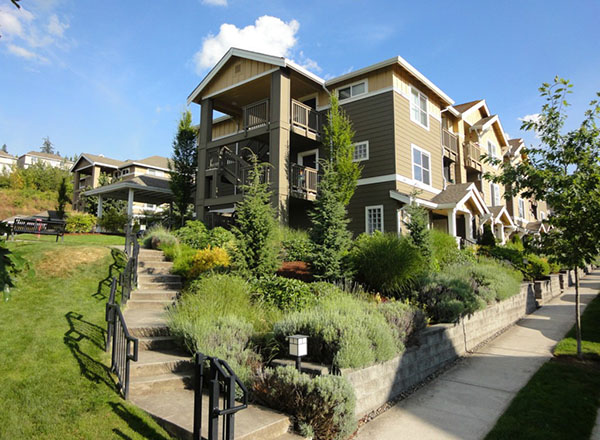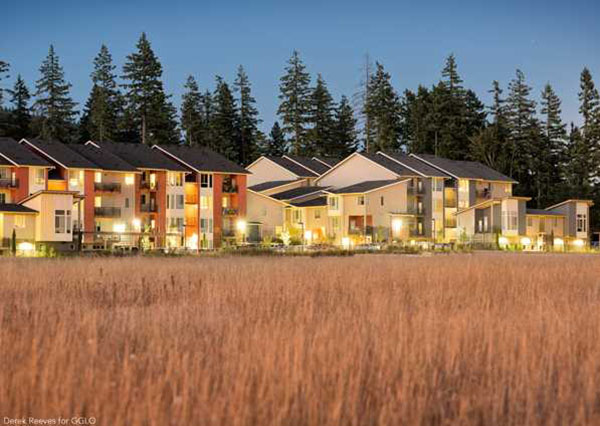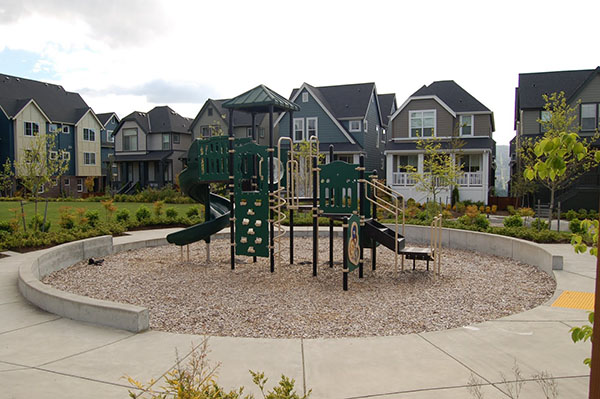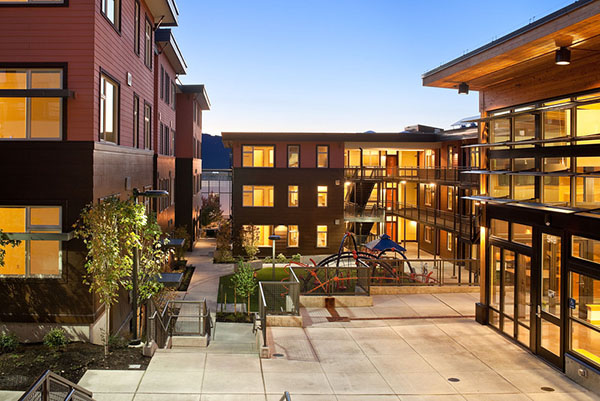In 1997, Port Blakely Communities (PBC) sought to provide an advanced communications infrastructure for the Issaquah Highlands development. PBC found a third party, Vialight, which under took to construct, operate, and own the network. At that time, PBC’s involvement was to install the conduit and vaults.

In 2001, Vialight ended its operation as a result of financial default. PBC assumed ownership and management responsibility of the network and formed HFN. PBC worked with the community to determine a long-term operating model that would facilitate payback of PBC’s investment in constructing and operating the network. Under current Covenant for Community provisions, when PBC realizes recovery of its investment, the community has the authority to own the network. A mandatory “Network Fee” (or mandatory fee) and connection requirement was implemented for all residents in the second phase (“Phase II”) of development in order to accomplish PBC’s financial recovery goals.
From 2001 to 2003, PBC made a number of technology changes in order to keep the network serviceable. What evolved was a mixed hardware and network architecture, which delivered poor quality service, was not engineered for advanced IP services, and the subscribers and residents constantly complained about the poor service. In 2004, HFN hired a General Manager/Sr. Network Engineer who designed, engineered, and oversaw the implementation of network architecture changes that required an additional investment by PBC to upgrade, deploy, and maintain the Fiber-to-the-Home (FTTH) technology to every home and commercial building. Also in 2004, the HFN operation was outsourced to a northwest regional Internet Service Provider (ISP). On or before this time, fiber construction was outsourced to a local construction company. In early 2005, the ISP was given operational constraints and limitations. Its operational scope was reduced to in-home setup; help desk, core Internet connection, and billing. In the course of implementing the ISP operational changes, the HFN technical platform evolved from an implementation of highly disintegrated network equipment to a standards-based IP, Ethernet, all fiber integrated platform positioned for advanced IP services and minimal maintenance. The conversion was completed in June of 2006.
IH has Covenants, Conditions, & Restrictions (CC&Rs) to maintain the community’s standards and govern the property rights of homeowners in the community. IH Community Association (IHCA) is the managing body of the CC&Rs for the homeowners. The IHCA primarily concerns itself with homeowner issues and is governed by a Board of Directors. There are separate CC&Rs and associations for apartment owners and for commercial owners.
The Highlands Council, which is a 501 (c) (4) entity, complements the role of the IHCA. The Highlands Council exists to promote greater community involvement, life enrichment, and communal sustainability with the responsibility of enhancing and ensuring the quality-of-life aspects for all of Issaquah Highlands. The Highlands Council considers the needs of the entire IH community, including homeowners, apartment dwellers, retail store owners, commercial offices, professional businesses, and HFN. A Board of Trustees governs the council.

The governing document developed and maintained by the Highlands Council is the recorded Covenant for Community for Issaquah Highlands. Early households, Phase I, in the community were sold prior to the formation of the Highlands Council and are not covered by the Covenant for Community. This represents approximately 422 homes. PBC expects conversion from non-covenant to covenant status at a rate of 10% per year.
Community residents make up an eight-member technology advisory committee known as the HFN Advisory Council. The HFN Advisory Council meets monthly and provides community input and guidance to HFN. The HFN Advisory Council is comprised primarily of residents. In addition to its own meetings, they also report regularly to the Highlands Council Board of Trustees. An Executive Director of Community, who works for PBC, manages the meetings, publications, and documentation of the HFN Advisory Council. The Advisory Council appointed a community HFN Task Force to oversee the communities’ interest in the business opportunity process, product changes, and price setting.
While there are several other community associations with their respective Board of Directors in Issaquah Highlands, the Highlands Council Board of Trustees serves as the community’s oversight entity for HFN.
In early 2006, Port Blakely appointed Rene Ancinas the new General Manager of HFN. After interviewing consulting groups, Rene hired Miapaz Partners to complete an Operational and Financial review. Miapaz Partners was selected because of their deep business, telecommunications, and technology experience. Miapaz completed their initial review during summer 2006. Results from their review suggested that HFN in its current model was not financially viable and it was having difficulty meeting the community’s long-term service requirements. As a result, Port Blakely decided to seek an alternative operating and potentially a new ownership model.
With the objective of developing an operating model that would align with the original vision for the network while enabling Port Blakely to recover its investment, HFN issued a Business Opportunity Proposal to twenty-one companies. After exhaustive review of all proposals, ISOMEDIA was chosen as the service provider, responsible for most of the network and business operations, including engineering, supervision of construction, on-site technical support, call center support, billing, and collections. A Master Services Agreement and Statement of Work (the Agreements) were negotiated to establish the working relationship and revenue splitting arrangement between ISOMEDIA and HFN. The initial term of the services contract continues through July 31, 2022. Excerpts of the Agreements are attached as appendices.
The Covenant for Community, as the primary document that establishes the roles and responsibilities of the community and of Port Blakely as it relates to HFN, defines the HFN founder as Port Blakely and the Highlands Council. It mandates that the amount of the Network Fee and Network Connection Fee will be determined by the sole discretion of the founder (including the allowance for price increases). It has always been the intent of the founder that HFN becomes a community asset once Port Blakely recovers a predetermined amount of its investment. It was determined that an increase in HFN fees would facilitate the long run sustainability of the network through the eventual change in ownership.
Based on surveys of residents and work with the HFN Advisory Council and Task Force, new service plans and fees were established as of August 1, 2007. The network facilities fee was set at $19.95 per month per household and the basic Internet Subscription fee was set at $21.95 per household per month for a circuit that delivers up to 6 megabits per second for both downloading and uploading. The two monthly fees for Internet access amounting to $41.90 constitute the “Periodic Fee” described in section 6.4 of the “Covenant for Community”. Higher speed plans were also offered, with the same network facilities fee and higher Internet Subscription fees, as shown in Table 1.1. In addition to changes to the monthly fees, the non-recurring Internet hookup fee that is charged to new residents of single-family housing was increased from $100 to $250 effective July 2007.
Under the Agreements, funding for future capital expenses fall under two classes, each subject to different management processes. The first class of capital expenditures is Outside Plant, which includes the fiber optic cables, conduit that supports the fiber distribution and labor costs incurred to install the fiber and conduit. Outside Plant capital expenditures continue to be the responsibility of HFN. Detailed estimates were developed for the cost of providing fiber to all of the remaining homes to be built along with the expected pace of the build-out. Future electronic equipment is the second class of capital expenditures and ISOMEDIA is responsible for the funding and purchasing of the electronics. The Agreements establish procedures for ISOMEDIA’s acquisition of the equipment within a bankruptcy-remote limited liability company (Electronics LLC), to be wholly owned by ISOMEDIA. The sole and limited purpose of Electronics LLC is to purchase and own the new electronics.
The Issaquah Highlands Planned Community, located in Issaquah, WA was conceived, planned, and developed by Port Blakely Communities starting in the late 1990’s. This community, which has a specific and identifiable perimeter, was designed to be a highly resident involved environment. Schools, parks, retail and gathering areas were designed in to create this close-knit social atmosphere.

In the early time of this planned development, community leaders envisioned and started to build a high speed FTTH (Fiber to the Home) internet service which would serve the existing and new residences within the borders of the community. Fiber optic medium was used by large telecommunications companies to move voice and data between cities and states, but widespread adoption for local use was not common. Hence, “Highlands Fiber Network” (HFN) was created and managed by Port Blakely Communities.
To ensure the success of such an undertaking, provisions were written into the land titles, a “Covenant for Community” which guaranteed subscriber adoption.
In 2013, Port Blakely Communities started to make its departure from the community, as most of the development had occurred, with just a handful of undeveloped areas remaining.
The fate and continued operation of HFN was now in question. The community was approached and consulted as to the continuing operation of the network, and possible solutions to keep it running.
The community took pride in the network, and in light of all competition serving the area, decided to outright purchase the network from Port Blakely Properties and all assets to ensure its continued operation.
The network was purchased in October 2013, and currently services just over 3,000 customers.
HFN functions as a very lean company, has only one employee, and continues in the purpose of providing the fastest, reliable fiber optic internet service to only the residences of the Issaquah Highlands. HFN has repeatedly been approached by other communities in and outside of the Issaquah City limits to provide internet service. HFN has no desire to expand outside of the geographic border of the community, as the company is not owned and operated to be a profit center. As the company is not owned by traditional investors, HFN only exists to provide the best and fastest communications in the community and keeps enough operating funds to pay for additional construction in the community, and other normal operating needs.
The goal of the Board of Directors is to keep costs low, while providing the highest service levels and rates below competition for this specific community. Since HFN is a community owned entity, every effort is made to give back to the community in the form of Wi-Fi hotspots, technology demonstration and event sponsorships.

In honor of it being Issaquah highlands birthday month it is only fitting to celebrate with a brief history of milestones for your community owned Highlands Fiber Network as it is one of the oldest in the United States. Issaquah Highlands is one of the first master-planned communities to have a fiber-to-the-home network. There are 34.5 million U.S. homes that have access to FTTH delivered services, which only accounts for 30% of all homes in the country according to a 2017 report by Fiber Broadband Association (formally the FTTH Council North America). As we find ourselves going online more for work, school, and other day-to-day activities fast, reliable internet service is a requirement. Fiber networks like HFN are becoming increasingly popular and sought after by cities, towns, and tenants around the world.
One of the focuses of Issaquah Highlands homes is to be as energy efficient as possible not every building planner nor developer was capable of this in the late 1990's. The construction of houses in Issaquah Highlands became a new standard to compare to. The idea of adding a fiber optic network came early on as some tech-savvy residents requested this upon moving into their new homes. A dedicated fiber optic network would be a perfect addition to the community. HFN chose fiber since it is “future proof” and to avoid relying upon cable companies or telcos.

HFN was originally built by a private company under an agreement with the developer. The original business model did not work and the company closed in late 2000. Port Blakely Communities took over the network and started to look for a regional Internet provider to deliver services. After a few tries of finding the right provider, ISOMEDIA, an independent service provider founded in 1991 in Redmond, WA., was selected. ISOMEDIA leveraged experience in servicing businesses and consumers with Internet and colocation services in the Seattle region, and brought operational and strategic know-how to the network. “Since we make it a goal to do everything in our power to stay competitive, we have accordingly increased our speed offerings so that everyone is able to choose the Internet service plan that fits their particular needs,” said Stephen Milton, CEO and CTO of ISOMEDIA. In 2014, ISOMEDIA created GigabitNow which focuses on offering a full range of fiber to the home services and fiber network operations support for communities across the western United States.
HFN is a community owned network which makes staying current with technology much easier. State-of-the-art technology is used giving residents the highest level of internet service with greater than 99 percent uptime. Improvements are continuously made to HFN to ensure the network is functioning at a high level. GigabitNow continues to manage the build out of the network and daily operations and support. Most homes in the Issaquah Highlands are already wired and ready to take advantage of the HFN community network. Homes have a network panel that includes all the hardware needed to connect to the fast, reliable Internet.
Highlands Fiber Network Customer Service can help you get the most out of your Network. They are available 24/7 at (425) 427-0999, www.highlandsfibernetwork.com or support@hfnservices.com.